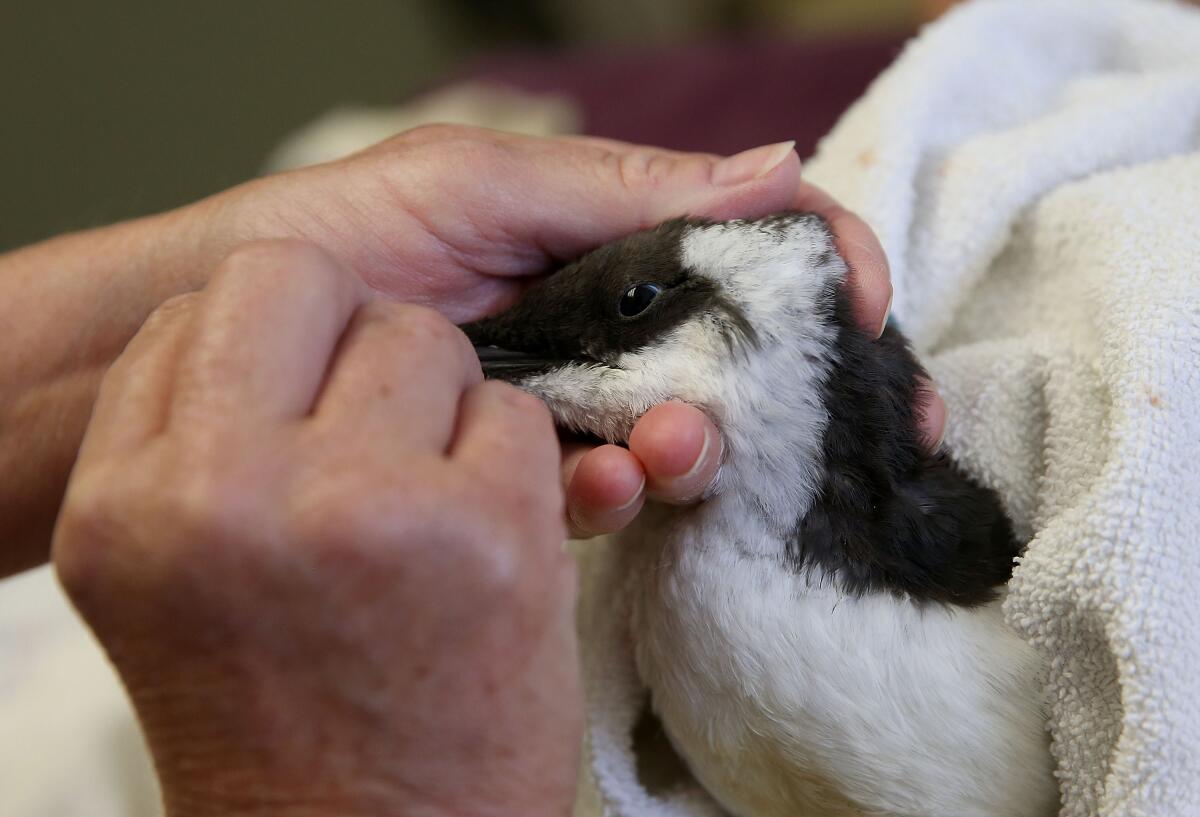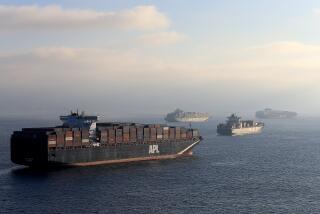Scientists were stumped when seabirds started dying. Now they have answers

- Share via
In the fall of 2015, two years into a heatwave in the Pacific Ocean colloquially known as “the Blob,” an unusually large influx of common murres, a small northern seabird, began to wash ashore.
They overwhelmed rehabilitation centers.
They stopped laying as many eggs.
Their starved carcasses littered the coasts from California to the Gulf of Alaska.
Scientists believe they now know what went wrong. The answer involves the Blob and how it rippled across multiple levels of the marine food web, and it comes amid more reports of rapidly warming oceans.
In the winter of 2013, a mysterious blanket of abnormally warm water appeared in the Gulf of Alaska and wreaked havoc on marine ecosystems from the Bering Strait to Mexico for three long years. Species lower in the food web that prefer colder waters, which tend to be fattier, more nutritious phytoplankton and zooplankton that feed the forage fish eaten by sea lions and sea birds — were replaced by warmer water species of lower nutritional value.
A whole new ecosystem was establishing itself all the way up the food chain, said Julia Parrish, professor of marine sciences at the University of Washington and a co-author on a new study published in PLOS One that characterizes murre mortality and breeding failures during the heatwave. Parrish also directs the Coastal Observation and Seabird Survey Team (COASST), the largest citizen monitoring program of beached birds in the world.
Fish populations shifted to colder or deeper waters, making it harder for top predators, including two types of auklets similar to murres, to find food.
But that still doesn’t explain the murres.
Common murres are the masters of their universe. One of the best adapted seabirds in the northern hemisphere, they can outfly other seabirds and speed from shelf to coast in a few hours. Underwater, they’re agile enough to catch fast-moving prey and strong enough to dive to the depth of two football fields.
If the fish move, they can move, too.
Yet half a million to 1.2 million common murres starved to death during the 2014 to 2016 marine heatwave — about 10% to 20% of the population, said John Piatt, wildlife biologist at the U.S. Geological Survey in Anchorage and the corresponding author on the study.
On a stretch of beach more than a half-mile long in Prince William Sound of Alaska, their carcasses numbered in the thousands.
Melanie Smith, a director based in Alaska for the National Audubon Society’s Migratory Bird Initiative, who was not affiliated with the study, recalls seeing murres as far inland as Fairbanks.
“The murres were so desperate for food, they were going to places they never go and had never been seen before,” Smith said. “They’re squarely an ocean species and don’t belong in freshwater environments at all. It was a clear sign something was wrong.”
Reproductive rates in murre colonies from California to the Bering Sea also plummeted alarmingly. Colonies that had been stable for decades stopped laying eggs. From 2015 to 2017, 22 murre colonies from California to the Bering Sea didn’t produce a single chick.
In all his years studying the birds, Piatt said he could count on one hand the number of colonies that had failed before 2015.
“These birds are so productive and efficient,” Piatt said. “This just doesn’t happen.”
Altogether, the die-offs spanned three marine ecosystems over 3,700 miles of coast and lasted up to nine months in the Gulf of Alaska, where the murres were hardest hit.
“Did that get my attention? Yeah, you bet,” said Piatt, who has been studying murres since the 1970s. “This level of mortality and over this range is just mind-blowing.”
Piatt suspected there was more to their plight than the redistribution of poorer quality prey, given the murres’ superlative ability to find food across the lengths and depths of the continental shelf.
Piatt and his colleagues looked again at the food supply, but through a different lens.
Researchers studying models of predator fish — including Pacific cod, arrowtooth flounder and walleye pollock, which compete with the common murre for food — projected that a 3.6 degree Fahrenheit increase in water temperatures would have jacked up fish appetites by 34% to 70%.
Given that predator fish already out-consume seabirds 10- to 100-fold under normal conditions, they would have completely decimated the food supply during the Blob. Sure enough, while dead murres were washing ashore in droves, adult Pacific cod populations in the Gulf of Alaska were “silently crashing” below the surface, Piatt said.
So the murres were hit with a double whammy that exploited one of their few vulnerabilities — their high metabolism.
The small seabird, which weighs about 2 pounds, must eat 56% of its body mass each day to survive — a daily diet of about 60 to 120 high-fat forage fish, including sardines, herring and capelin. Without food, murres starve to death within three to five days.
Many of the dead or dying murres that washed ashore had empty stomachs and little to no body fat or muscle.
“As the bottom of the ecosystem was shifting in not good ways, the top of the ecosystem was demanding a lot more food,” Parish said. The murres got caught in “an intense competition for absolutely not enough food, which is what killed them.”
In many ways, the murres are the perfect climate change bellweather.
While the Blob eventually dissipated and murre populations stabilized, the heatwave offered a glimpse into how warming oceans in a warmer world push marine populations toward collapse.
This month, a study in Advances in Atmospheric Sciences reported that global ocean temperatures in 2019 were the warmest on record, a trend that has continued for the last decade.
A recent special report from the Intergovernment Panel on Climate Change found that marine heatwaves have doubled in frequency since 1982 and are expected to become 20 to 50 times more frequent if we don’t curb greenhouse gas emissions. The panel also projected that oceans will absorb two to four times more heat by the end of the century than they did in the past 50 years if global warming is limited to 3.6 degrees.
On Wednesday, NOAA and NASA released a report that the last decade was the hottest on record worldwide.
Climate change isn’t just a long-term upward trend in which each year is warmer than the last, Parrish said. Climate change also brings more extreme weather patterns, including unpredictable marine heatwaves of greater frequency and magnitude.
“We don’t know whether we’ll look back at this period of time as five years of die-offs being reported very frequently or as the beginning of a new normal condition,” said Smith.
“Many of the species that we’re talking about — both the birds and the fish — are pretty resilient,” Parrish said. A murre might live for 20 or 25 years and over that period of time, lay 10 or 15 eggs, more than enough to replace itself and its mate.
But what happens if they are assaulted by another or several Blobs? In the summer of 2019, a warm mass of water appeared in the Gulf of Alaska that resembled the original Blob of 2014. The heatwave has since shrunk in size but remains one of the five largest heatwaves on record in the North Pacific in the last 40 years, according to NOAA.
“So we’re all sort of sitting on the edge of our seats. ... It seems like we’ve just about gotten back to normal down here in the lower 48 states,” Parrish said. “There’s only so much a population can take before they go into free fall.”







